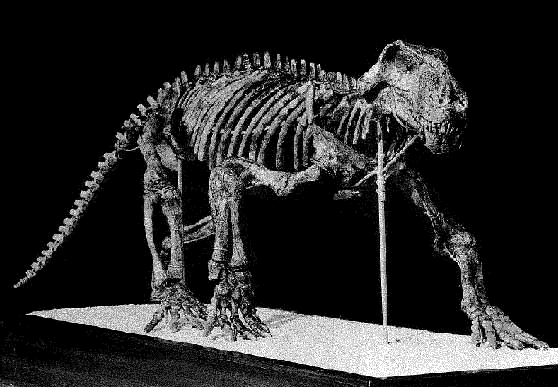Rank Suborder | Scientific name Gorgonopsia Higher classification Theriodont Order Therapsid | |
 | ||
Family †GorgonopsidaeLydekker, 1890 Similar | ||
Gorgonopsia ("Gorgon face") is an extinct suborder of therapsid synapsids. Like other therapsids, gorgonopsians (or gorgonopsids) were at one time called "mammal-like reptiles", though "stem mammals" is more accurate.
Contents

Description

Their mammalian specializations include differentiated (heterodont) tooth shape, a fully developed temporal fenestra, pillar-like rear legs, a vaulted palate that may have facilitated breathing while holding the prey, and incipiently developed ear bones. Gorgonopsians are a part of a group of therapsids called theriodonts, which includes mammals. They were among the largest carnivores of the late Permian. The largest known, Inostrancevia, was the size of a large bear with a 45 centimetres (18 inches) long skull, and 12 centimetres (4.7 in) long saber-like teeth (clearly an adaptation to being a carnivore). They are traditionally thought to not have had a full pelage, but some Late Permian coprolites showcasing remnants of fur may belong to them; whether they had bristles or scales is unknown. They possibly had a combination of all of them, as some mammals still do. Like most therapsids, they are assumed to have been terrestrial, and this is supported both by their morphology and bone microanatomy.
Evolutionary history

Gorgonopsians are theriodonts, a major group of therapsids that included the ancestors of mammals. They evolved in the Middle Permian, from a reptile-like therapsid that also lived in that period. The early gorgonopsians were small, being no larger than a dog. The extinction of dinocephalians (which dominated the Middle Permian world) led to gorgonopsids becoming the apex predators of the Late Permian. Some had approached the size of a rhinoceros, such as Inostrancevia, the largest gorgonopsian. A nearly complete fossil of Rubidgea has been found in South Africa. The Gorgonopsia became extinct at the end of the Permian period, being the only theriodont line to be terminated by this mass extinction.
Classification
The gorgonopsians are one of the three groups of theriodonts (the other two were the therocephalians, and the cynodonts). Theriodonts are related to the herbivorous Anomodontia. Gorgonopsia includes three subfamilies, the Gorgonopsinae, Rubidgeinae and Inostranceviinae, plus a larger number of genera that have not been placed in any of these groups. In all, there are 25 genera and 41 species, with the genera described most completely being Dinogorgon, Inostrancevia and Rubidgea.
The most comprehensive review of the group is by Sigogneau-Russell, 1989.
Gebauer (2007) conducted a phylogenetic analysis of gorgonopsians. She did not consider Gorgonopsia and Gorgonopsidae to be equivalent, and placed only species with autapomorphies, or characteristics unique to those species, in Gorgonopsidae; accordingly, Aloposaurus, Cyonosaurus, and Aelurosaurus were placed outside Gorgonopsidae as basal gorgonopsids. Below is a cladogram resulting from her analysis:
Paleobiology
Gorgonopsids were likely active predators, based on their powerful senses of smell and their fairly good eyesight. Gorgonopsids were also seemingly plantigrade walkers, based on their skeletal morphology, and probably possessed a gait similar to a "crocodilian high-walk". This posture would have permitted them to be much faster than many of their potential prey species, such as dicynodonts and pareiasaurs, particularly in conjunction with their reduced, almost mammalian phalangeal formula and more symmetrical feet. Their hunting strategy was probably one of ambush; lying in wait before lunging at speed to grapple prey with their front limbs and attack their prey with their saber-teeth. Unlike later sabertooths such as the machairodontines, gorgonopsids likely were less precise in regards to bite placement; as they had reptilian jaws and tooth arrangements, gorgonopsids probably hunted by using a bite-and-retreat technique to weaken and debilitate their victim before moving in to attack the throat, underbelly and other vulnerable areas. Due to the fact that most gorgonopsids lack any post-canine cutting teeth, meat would have been torn away from a carcass using the powerful jaw muscles and incisors before being gulped down and swallowed whole.
